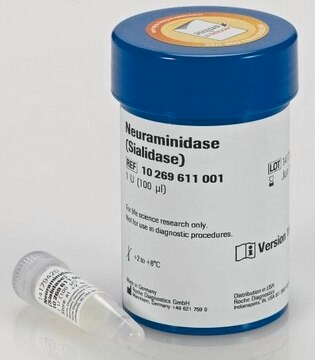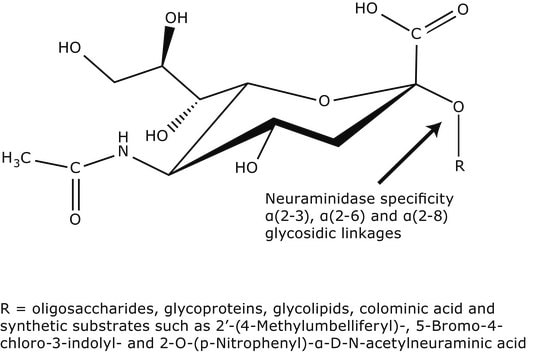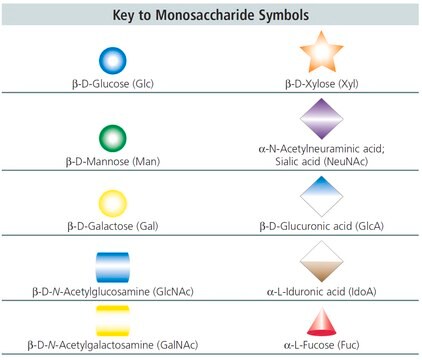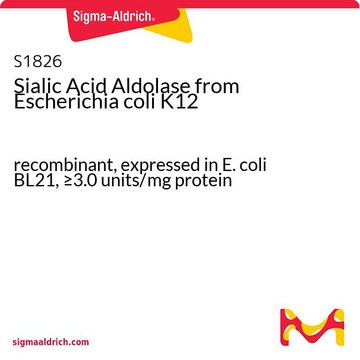N3786
α(2→3,6,8,9) Neuraminidase from Arthrobacter ureafaciens
Proteomics Grade, suitable for MALDI-TOF MS
Sinónimos:
Neuraminidase from Arthrobacter ureafaciens, Acyl-neuraminyl Hydrolase, Sialidase
Iniciar sesiónpara Ver la Fijación de precios por contrato y de la organización
About This Item
Productos recomendados
form
lyophilized powder
Quality Level
quality
Proteomics Grade
specific activity
≥25 U/vial
suitability
suitable for MALDI-TOF MS
storage temp.
2-8°C
¿Está buscando productos similares? Visita Guía de comparación de productos
Application
Neuraminidase is an important deglycosylation enzyme capable of cleaving all non-reducing unbranched N-acetylneuraminic and N-glycolylneuraminic acid residues by hydrolysis of α(2→6), α(2→3), α(2→8), and α(2→9) linkages (affinity in the order given). Branched sialic acids may also be cleaved with the use of high concentrations of enzyme and prolonged incubations. Desialylated glycoproteins may then be further characterized by treatment with various exoglycosidases resulting in partial or complete O-deglycosylation. SDS-PAGE and MALDI-TOF MS are typically utilized in purification, structural analysis, and sequencing process. These techniques also remove heterogeneity and charge from the glycoprotein.
Packaging
Provided with 5× concentrate reaction buffer.
Quality
The buffer solution has been specifically formulated to assure maximum enzyme stability and assay sensitivity.
Unit Definition
One unit will release 1 nmole of 4-methylumbelliferone from 2-(4-methylumbelliferyl) α-D-N-acetylneuraminic acid per minute at pH 5.5 at 37° C.
Physical form
Lyophilized powder
Los componentes del kit también están disponibles por separado
Referencia del producto
Descripción
SDS
- N3536Neuraminidase 5X Reaction Buffer 1.5 mLSDS
Related product
Referencia del producto
Descripción
Precios
signalword
Danger
hcodes
pcodes
Hazard Classifications
Resp. Sens. 1
Storage Class
11 - Combustible Solids
wgk_germany
WGK 1
flash_point_f
Not applicable
flash_point_c
Not applicable
Elija entre una de las versiones más recientes:
¿Ya tiene este producto?
Encuentre la documentación para los productos que ha comprado recientemente en la Biblioteca de documentos.
Los clientes también vieron
Natallia Makarava et al.
Acta neuropathologica communications, 6(1), 92-92 (2018-09-14)
Last decade witnessed an enormous progress in generating authentic infectious prions or PrPSc in vitro using recombinant prion protein (rPrP). Previous work established that rPrP that lacks posttranslational modification is able to support replication of highly infectious PrPSc with assistance
Hongyun Li et al.
PloS one, 11(2), e0148238-e0148238 (2016-02-02)
Recent studies have shown that cerebral apoD levels increase with age and in Alzheimer's disease (AD). In addition, loss of cerebral apoD in the mouse increases sensitivity to lipid peroxidation and accelerates AD pathology. Very little data are available, however
Michael Worobey et al.
Nature, 508(7495), 254-257 (2014-02-18)
Zoonotic infectious diseases such as influenza continue to pose a grave threat to human health. However, the factors that mediate the emergence of RNA viruses such as influenza A virus (IAV) are still incompletely understood. Phylogenetic inference is crucial to reconstructing
Nenad Macesic et al.
The Medical journal of Australia, 198(7), 370-372 (2013-04-16)
To review cases of nosocomial influenza and compare the epidemiology, clinical characteristics and outcomes with community-acquired cases. Prospective case series of adults hospitalised with influenza during April - November of 2010 and 2011 using a hospital-based sentinel surveillance system. A
Dominic Meusch et al.
Nature, 508(7494), 61-65 (2014-02-28)
Tripartite Tc toxin complexes of bacterial pathogens perforate the host membrane and translocate toxic enzymes into the host cell, including in humans. The underlying mechanism is complex but poorly understood. Here we report the first, to our knowledge, high-resolution structures
Artículos
Glycan Sequencing Using Exoglycosidases
Nuestro equipo de científicos tiene experiencia en todas las áreas de investigación: Ciencias de la vida, Ciencia de los materiales, Síntesis química, Cromatografía, Analítica y muchas otras.
Póngase en contacto con el Servicio técnico









